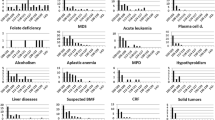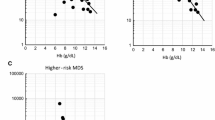Abstract
To clarify whether measurement of serum haptoglobin (Hp) has impact on understanding pathophysiology in bone marrow failure (BMF) syndromes, we investigated concentrations of serum Hp by nephelometric procedure in 156 Japanese patients with BMF, including 54 aplastic anemia (AA), 50 paroxysmal nocturnal hemoglobinuria (PNH), and 52 myelodysplastic syndromes (MDS) patients. The frequencies with low concentrations of serum Hp (<42 mg/dL) in PNH patients (98.0%) were significantly higher than those in AA (27.8%; P < 0.0001) and MDS (38.5%; P < 0.0001) patients. In AA patients, white blood cell (WBC), absolute neutrophil, and platelet counts were significantly decreased in the group (n = 15) with low concentrations of serum Hp than in that (n = 39) with normal concentrations of it, and WBC counts were positively correlated with concentrations of serum Hp, suggesting that WBC counts may affect the concentrations. In MDS patients, hemoglobin concentrations and serum iron were significantly decreased and increased, respectively, in the group (n = 20) with low concentrations of serum Hp than in that (n = 32) with normal concentrations of it, and the values of serum iron were inversely correlated with concentrations of serum Hp, suggesting that ineffective erythropoiesis may affect the concentrations. Several AA and MDS patients with low concentrations of serum Hp had Coombs-negative autoimmune hemolytic anemia determined by immunoradiometric assay. In conclusion, several factors in conjunction with pathophysiology contribute to decrease of serum Hp in BMF.

Similar content being viewed by others
References
Young NS. The problem of clonality in aplastic anemia: Dr Dameshek’s riddle, restated. Blood. 1992;79:1385–92.
Shichishima T, Noji H. A new aspect of the molecular pathogenesis of paroxysmal nocturnal hemoglobinuria. Hematology. 2002;7:211–27.
Wang H, Chuhjo T, Yasue S, Omine M, Nakao S. Clinical significance of a minor population of paroxysmal nocturnal hemoglobinuria-type cells in bone marrow failure syndromes. Blood. 2002;100:3897–902.
Sugimori C, Chuhjo T, Feng X, Yamazaki H, Takami A, Teramura M, et al. Minor population of CD55−CD59− blood cells predicts response to immunosuppressive therapy and prognosis in patients with aplastic anemia. Blood. 2006;107:1308–14.
Parker C, Omine M, Richards S, Nishimura J, Bessler M, Ware R, et al. Diagnosis and management of paroxysmal nocturnal hemoglobinuria. Blood. 2005;106:3699–709.
Wejman JC, Hovsepian D, Wall JS, Hainfeld JF, Greer J. Structure of haptoglobin and the haptoglobin–hemoglobin complex by electron microscopy. J Mol Biol. 1984;174:319–41.
Kristiansen M, Graversen JH, Jacobsen C, Sonne O, Hoffman HJ, Law SK, et al. Identification of the haemoglobin scavenger receptor. Nature. 2001;409:198–201.
Gabay C, Kushner I. Acute-phase proteins and other systemic response to inflammation. N Engl J Med. 1999;340:448–54.
Langlois MR, Delanghe JR. Biological and clinical significance of haptoglobin polymorphism in humans. Clin Chem. 1996;42:1589–600.
Shinton NK, Richardson RW, Williams JDF. Diagnostic value of serum haptoglobin. J Clin Path. 1965;18:114–8.
Owen JA, Smith R, Padanyi R, Martin R. Serum haptoglobin in disease. Clin Sci. 1964;26:1–6.
International Agranulocytosis and Aplastic Anemia Study. Incidence of aplastic anemia: the relevance of diagnostic criteria. Blood. 1987;70:1718–21.
Frickhofen N, Kaltwasser JP, Schrezenmeier H, Raghavachar A, Vogh HG, Herrmann F, et al. Treatment of aplastic anemia with antilymphocyte globulin and methylprednisolone with or without cyclosporine. N Engl J Med. 1991;324:1297–304.
Shichishima T, Terasawa T, Hashimoto C, Ohto H, Uchida T, Maruyama Y. Heterogeneous expression of decay accelerating factor and CD59/membrane attack complex inhibition factor on paroxysmal nocturnal haemoglobinuria (PNH) erythrocytes. Br J Haematol. 1991;78:545–50.
Hall SE, Rosse WF. The use of monoclonal antibodies and flow cytometry in the diagnosis of paroxysmal nocturnal hemoglobinuria. Blood. 1996;87:5332–40.
Bennett JM, Catovsky D, Daniel MT, Flandrin G, Galton DA, Gralnick HR, et al. The French-American-British (FAB) Cooperative Group. Proposals for the classification of the myelodysplastic syndromes. Br J Haematol. 1982;51:189–99.
Harris NL, Jaffe ES, Dieboid J, Flandrin G, Muller-Hermelink HK, Vardiman J, et al. World Health Organization of neoplastic diseases of the hematopoietic and lymphoid tissues: report of the clinical advisory committee meeting-Airlie House, Virginia, November 1997. J Clin Oncol. 1999;17:3835–49.
Lewis SM, Dacie JP. The aplastic anaemia-paroxysmal nocturnal haemoglobinuria syndrome. Br J Haematol. 1967;13:236–51.
Shichishima T, Terasawa T, Saitoh Y, Hashimoto C, Ohto H, Maruyama Y. Diagnosis of paroxysmal nocturnal haemoglobinuria by phenotypic analysis of erythrocytes using two-colour flow cytometry with monoclonal antibodies to DAF and CD59/MACIF. Br J Haematol. 1993;85:378–86.
Okamoto M, Shichishima T, Noji H, Ikeda K, Nakamura A, Akutsu K, et al. High frequency of several PIG-A mutations in patients with aplastic anemia and myelodysplastic syndrome. Leukemia. 2006;20:627–34.
Ikeda K, Shichishima T, Yasukawa M, Nakamura-Shichishima A, Noji H, Akutsu K, et al. The role of Wilms’ tumor gene peptide-specific cytotoxic T lymphocytes in immunologic selection of a paroxysmal nocturnal hemoglobinuria clone. Exp Hematol. 2007;35:618–26.
Van Lente F, Marchand A, Galen RS. Evaluation of a nephelometric assay for haptoglobin and its clinical usefulness. Clin Chem. 1979;25:2007–10.
Dati F, Schumann G, Thomas L, Aguzzi F, Baudner S, Bienvenu J, et al. Consensus of a group of professional societies and diagnostic companies on guidelines for interim reference ranges for 14 proteins in serum based on the standardization against the IFCC/BCR/CAP reference material (CRM 470). Eur J Clin Chem Clin Biochem. 1996;34:517–20.
Kirch M, Genth E. Haptoglobin-serumkonzentration und haptoglobin-polymorphismus bei entzündlich-rheumatischen erkrankungen. Medwelt. 1990;41:319–24.
Jeje MO, Blajchman MA, Steeves K, Horsewood P, Kelton JG. Quantitation of red cell associated IgG using an immunoradiometric assay. Transfusion. 1984;24:473–6.
Kajii E, Oomi T, Miura S, Ikemoto N. A new approach for diagnosis of autoimmune hemolytic anemia. Jpn J Clin Hematol. 1993;35:336–40.
Kondo H, Kajii E, Oyamada T, Kasahara Y. Direct antiglobulin test negative autoimmune hemolytic anemia associated with autoimmune hepatitis. Int J Hematol. 1998;68:439–43.
Shimamoto T, Ohyashiki K. Immunosuppressive treatments for myelodysplastic syndromes. Leuk Lymphoma. 2003;44:593–604.
Kamesaki T, Oyamada T, Omine M, Ozawa K, Kajii E. Cut-off value of red-blood-cell-bound IgG for the diagnosis of Coombs-negative autoimmune hemolytic anemia. Am J Hematol. 2009;84:98–101.
Theilgaard-Mönch K, Jacobsen LC, Nielsen WJ, Rasmussen T, Udby L, Gharib M, et al. Haptoglobin is synthesized during granulocytes, stored in specific granules, and released by neutrophils in response to activation. Blood. 2006;108:353–61.
Buckstein R, Jang K, Friedlich J, Zhang L, Reis M, Chesney A, et al. Estimating the prevalence of myelodysplastic syndromes in patients with unexplained cytopenias: a retrospective study of 322 bone marrows. Leuk Res. 2009;33:1313–8.
Marsh JCW, Hows JM, Bryett KA, Al-Hashimi S, Fairhead SM, Gordon-Smith EC. Survival after antilymphocyte globulin therapy for aplastic anemia depends on disease severity. Blood. 1987;70:1046–52.
Tichelli A, Gratwohl A, Nissen C, Signer E, Gysi CS, Speck B. Morphology in patients with severe aplastic anemia treated with antilymphocyte globulin. Blood. 1992;80:337–45.
Acknowledgments
This study was supported in part by a Grant-in-Aid for Medical Research from the Fukushima Prefectural Hospitals (No. 133) to T.S. We thank Ms. Miyuki Kikuchi (SRL, Inc.) or Ms. Sayuri Mizuno (Fukushima Medical University) and Ms. Tomoko Hikichi (Fukushima Research Institute of Environment and Medicine) for technical assistance of nephelometry or of flow cytometry, respectively. We are also grateful to Dr Tomoaki Akagi (Aomori Prefectural Central Hospital, Japan), Dr Kazuei Ogawa (Fukushima Medical University), Dr Masayuki Mita (Hoshi General Hospital, Japan), Dr Hiroyuki Kanbayashi (Ohta Nishino-uchi Hospital), Dr Shin Matsuda (Ohta Nishino-uchi Hospital), Dr Rokuo Abe (Fukushima-ken Taiyo-no-kuni Hospital, Japan), Dr Kenichi Nakamura (Shirakawa-kohsei Hospital, Japan), and Dr Toshiaki Sai (Iwaki Kyouritsu Hospital, Japan) for providing the samples from patients with BMF syndromes. We are indebted to Dr Yuji Sugita (Showa University, Japan) who provided the monoclonal antibody to CD59/membrane complex-inhibitory factor.
Author information
Authors and Affiliations
Corresponding author
Additional information
T. Shichishima, K. Ikeda, N. Takahashi, J. Kameoka, K. Tajima, K. Murai, Y. Tamai, A. Shichishima-Nakamura, K. Akutsu, H. Noji, M. Okamoto, H. Kimura, H. Harigae, Y. Takeishi and K. Sawada belong to the Study Group of Tohoku Hematology Forum.
About this article
Cite this article
Shichishima, T., Ikeda, K., Takahashi, N. et al. Low concentration of serum haptoglobin has impact on understanding complex pathophysiology in patients with acquired bone marrow failure syndromes. Int J Hematol 91, 602–610 (2010). https://doi.org/10.1007/s12185-010-0559-z
Received:
Revised:
Accepted:
Published:
Issue Date:
DOI: https://doi.org/10.1007/s12185-010-0559-z




